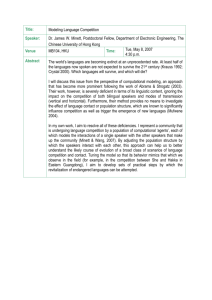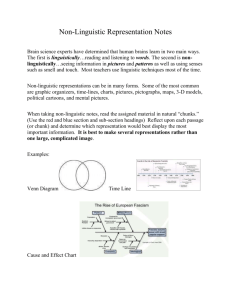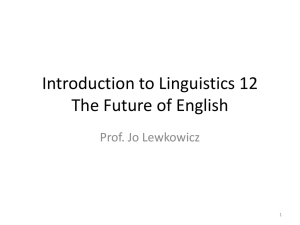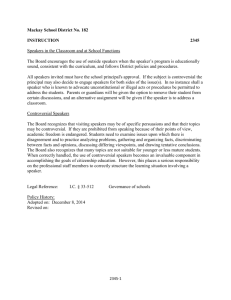doc
advertisement
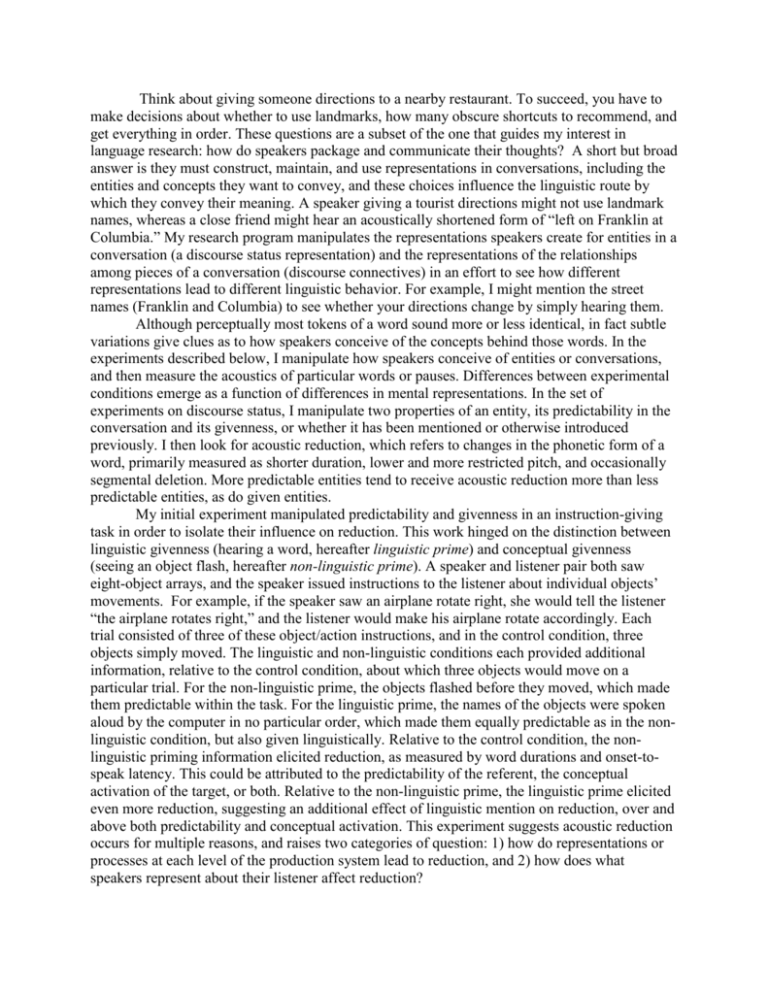
Think about giving someone directions to a nearby restaurant. To succeed, you have to make decisions about whether to use landmarks, how many obscure shortcuts to recommend, and get everything in order. These questions are a subset of the one that guides my interest in language research: how do speakers package and communicate their thoughts? A short but broad answer is they must construct, maintain, and use representations in conversations, including the entities and concepts they want to convey, and these choices influence the linguistic route by which they convey their meaning. A speaker giving a tourist directions might not use landmark names, whereas a close friend might hear an acoustically shortened form of “left on Franklin at Columbia.” My research program manipulates the representations speakers create for entities in a conversation (a discourse status representation) and the representations of the relationships among pieces of a conversation (discourse connectives) in an effort to see how different representations lead to different linguistic behavior. For example, I might mention the street names (Franklin and Columbia) to see whether your directions change by simply hearing them. Although perceptually most tokens of a word sound more or less identical, in fact subtle variations give clues as to how speakers conceive of the concepts behind those words. In the experiments described below, I manipulate how speakers conceive of entities or conversations, and then measure the acoustics of particular words or pauses. Differences between experimental conditions emerge as a function of differences in mental representations. In the set of experiments on discourse status, I manipulate two properties of an entity, its predictability in the conversation and its givenness, or whether it has been mentioned or otherwise introduced previously. I then look for acoustic reduction, which refers to changes in the phonetic form of a word, primarily measured as shorter duration, lower and more restricted pitch, and occasionally segmental deletion. More predictable entities tend to receive acoustic reduction more than less predictable entities, as do given entities. My initial experiment manipulated predictability and givenness in an instruction-giving task in order to isolate their influence on reduction. This work hinged on the distinction between linguistic givenness (hearing a word, hereafter linguistic prime) and conceptual givenness (seeing an object flash, hereafter non-linguistic prime). A speaker and listener pair both saw eight-object arrays, and the speaker issued instructions to the listener about individual objects’ movements. For example, if the speaker saw an airplane rotate right, she would tell the listener “the airplane rotates right,” and the listener would make his airplane rotate accordingly. Each trial consisted of three of these object/action instructions, and in the control condition, three objects simply moved. The linguistic and non-linguistic conditions each provided additional information, relative to the control condition, about which three objects would move on a particular trial. For the non-linguistic prime, the objects flashed before they moved, which made them predictable within the task. For the linguistic prime, the names of the objects were spoken aloud by the computer in no particular order, which made them equally predictable as in the nonlinguistic condition, but also given linguistically. Relative to the control condition, the nonlinguistic priming information elicited reduction, as measured by word durations and onset-tospeak latency. This could be attributed to the predictability of the referent, the conceptual activation of the target, or both. Relative to the non-linguistic prime, the linguistic prime elicited even more reduction, suggesting an additional effect of linguistic mention on reduction, over and above both predictability and conceptual activation. This experiment suggests acoustic reduction occurs for multiple reasons, and raises two categories of question: 1) how do representations or processes at each level of the production system lead to reduction, and 2) how does what speakers represent about their listener affect reduction? I addressed the first question in a series of experiments that targeted two levels of representation: conceptual and articulatory. These levels are theory-relevant because speakers are thought to represent givenness at the conceptual level and to modulate acoustics at the articulatory level. To prime the articulatory level, speakers saw a trio of objects and either named them aloud or silently to themselves. They then issued the instructions, as above. Facilitating articulation caused more reduction, as evidenced by a difference between the spoken-aloud and silently-named conditions. To prime the conceptual level, speakers experienced either a linguistic or non-linguistic prime that did not make the target object (i.e. the uttered object) predictable. In this case, the linguistic prime elicited reduction while the non-linguistic prime did not. Together, the results suggest that influencing reduction may require influencing postconceptual processing in some way. At the very least, influencing the conceptual level by itself does not appear to elicit reduction, but influencing the articulatory level in addition to other levels does. A second set of experiments examined listener-directed reduction in more detail by manipulating the speaker’s representation of the listener’s knowledge. The original experiment in this line showed both participants the same prime, such that the speaker might have reduced because of her primed representations, while ignoring the listener. An experiment that gave the priming information to each participant separately showed that speakers reduced when and only when they had the priming information, irrespective of their listener. A follow-up experiment with a more interactive task and a more conversational carrier phrase (“Make the airplane rotate”), however, showed that either the speaker or the listener introducing an entity elicited the same amount of reduction. These experiments provide conflicting evidence about whether the speaker’s representation of the listener creates reduction, or whether his/her own internal representations do, but add to the current debate by circumscribing situations when speakers do and do not attend to listeners. In addition to discourse status, speakers also maintain higher-order discourse-level representations, and appear to make acoustic choices based on them. A trio of sentences like I ate some breakfast. I had a bagel. And I indulged in an ice cream cone. has two possible interpretations: the speaker either had the bagel for breakfast, or later as a separate meal. In an experiment, our participants saw such sentences, as well as a picture meant to bias their conceptualization toward one meaning or another. They then read the story out loud, and their pauses were measured. Speakers paused for a shorter time when talking about a bagel eaten with breakfast than at another meal. However, these same sound files played aloud to a comprehender elicited only increased confidence, not accuracy. This suggests that either comprehenders are not sufficiently sensitive to detect the statistically significant pause differences, or that pausing does not capture all of the necessary acoustic information. Although inchoate, this research represents the beginning of a program to create a taxonomy of the relationship between representations of discourse connectives and behavioral outcomes such as acoustics. Both discourse status and discourse connectives have some psychological reality, as evidenced above. Differences in representation in these two domains lead to differences in behavior, specifically the acoustic realization of utterances. Moving forward, I intend to investigate exactly what type of discourse status representation is necessary and/or sufficient for reduction, as a means of characterizing exactly how speakers conceive of the entities they want to talk about. Similarly, I will attempt to quantify the relationship between a speaker’s representation of a discourse connective and his/her acoustic realization of the acoustics of that discourse.

